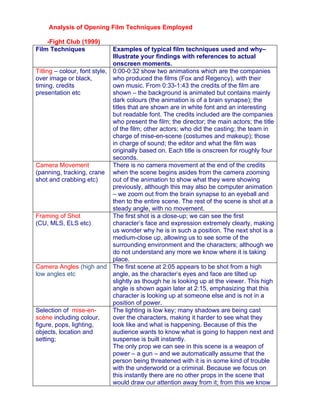
Fight Club
- 1. Analysis of Opening Film Techniques Employed -Fight Club (1999) Film Techniques Examples of typical film techniques used and why– Illustrate your findings with references to actual onscreen moments. Titling – colour, font style, 0:00-0:32 show two animations which are the companies over image or black, who produced the films (Fox and Regency), with their timing, credits own music. From 0:33-1:43 the credits of the film are presentation etc shown – the background is animated but contains mainly dark colours (the animation is of a brain synapse); the titles that are shown are in white font and an interesting but readable font. The credits included are the companies who present the film; the director; the main actors; the title of the film; other actors; who did the casting; the team in charge of mise-en-scene (costumes and makeup); those in charge of sound; the editor and what the film was originally based on. Each title is onscreen for roughly four seconds. Camera Movement There is no camera movement at the end of the credits (panning, tracking, crane when the scene begins asides from the camera zooming shot and crabbing etc) out of the animation to show what they were showing previously, although this may also be computer animation – we zoom out from the brain synapse to an eyeball and then to the entire scene. The rest of the scene is shot at a steady angle, with no movement. Framing of Shot The first shot is a close-up; we can see the first (CU, MLS, ELS etc) character’s face and expression extremely clearly, making us wonder why he is in such a position. The next shot is a medium-close up, allowing us to see some of the surrounding environment and the characters; although we do not understand any more we know where it is taking place. Camera Angles (high and The first scene at 2:05 appears to be shot from a high low angles etc angle, as the character’s eyes and face are tilted up slightly as though he is looking up at the viewer. This high angle is shown again later at 2:15, emphasizing that this character is looking up at someone else and is not in a position of power. Selection of mise-en- The lighting is low key; many shadows are being cast scène including colour, over the characters, making it harder to see what they figure, pops, lighting, look like and what is happening. Because of this the objects, location and audience wants to know what is going to happen next and setting; suspense is built instantly. The only prop we can see in this scene is a weapon of power – a gun – and we automatically assume that the person being threatened with it is in some kind of trouble with the underworld or a criminal. Because we focus on this instantly there are no other props in the scene that would draw our attention away from it; from this we know
- 2. that the important part of the scene is what is happening straight away and not the environment or anything else happening. From what we can see of the background, we assume that the characters are in a building. We cannot see any objects such as chairs or tables that would show that they are in an office, but we can see a wall in the background at 2:09, showing us that they are inside. The colours used are very dark, such as greys and blacks with some lighter blues used, telling us that the location is unfriendly and/or set at night to achieve a sense of solidarity. Editing directions The only shots used in the short scene at the end of the (Match cuts, jump cut, credits are matched cuts – this allows the viewer to know reverse shots etc) that they are watching a scene that is entirely in order, even though they might not know what is going on. No reverse shots are used even though dialogue is exchanged between the characters, allowing us to focus on the one person we can see. Sound techniques During the credits (0:33-1:43) loud background music (diegetic, non diegetic, plays which makes the audience feel ready for action – it silence, dialogue sounds like it belongs in a fight or action sequence instead of the beginning titles of a film, which in turn makes us feel as though the film is going to be very action-oriented. As the last credits roll, the music suddenly fades out and leaves us with silence, making us wonder what is going to happen next and heightening the suspense. At (2:07), non-diegetic dialogue begins to play as we cannot see who is doing the voice-over. However we assume that it is the voice of the first character we see, as someone else speaks at (2:10) to the man we have seen. Actor’s positioning and The man that we see is never directly at the centre of the movement screen, but is always a little to the right. This is significant because it tells us that this character might not be the main character and is only going to be around for this scene; however because he takes up roughly 1/3 of each shot we also know he must be integral to the plot. He does not move as he is being threatened with a weapon.
- 3. - a screenshot of part of the opening credits. All of the titles have the same font and are roughly against the same background. -2:06; appears to be shot from a high angle. The actor is looking directly at the camera but his head is titled back. -2:17; medium close-up shot is level with the character on the floor. We cannot see the other character; this makes us wonder who he is.